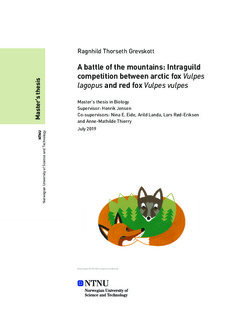| dc.contributor.advisor | Jensen, Henrik | |
| dc.contributor.advisor | Eide, Nina Elisabeth | |
| dc.contributor.advisor | Landa, Arild | |
| dc.contributor.advisor | Rød-Eriksen, Lars | |
| dc.contributor.advisor | Thierry, Anne-Mathilde | |
| dc.contributor.author | Grevskott, Ragnhild Thorseth | |
| dc.date.accessioned | 2019-09-26T14:00:07Z | |
| dc.date.available | 2019-09-26T14:00:07Z | |
| dc.date.issued | 2019 | |
| dc.identifier.uri | http://hdl.handle.net/11250/2619020 | |
| dc.description.abstract | Fjellreven (Vulpes lagopus) er en truet art i Fennoskandia. Konkurranse med rødreven (Vulpes vulpes) er regnet som en av hovedtruslene for fjellrevens utbredelse. Flere bevaringstiltak har blitt satt i gang for å redde fjellreven, både støttefôring av fjellreven, uttak av rødrev og et avls- og reintroduksjonsprogram. Gjennom de siste tiårene har disse tiltakene ført til en vekst i de gjenværende fjellrevpopulasjonene i Fennoskandia. I dette studiet undersøkte jeg deler av et konseptuelt modell-rammeverk som foreslår at konkurransestyrken til de to artene avhenger av deres relative populasjonsstørrelse, nemlig at rødreven er den dominante konkurrenten ved små populasjonsstørrelser av fjellrev, mens fjellreven er den dominante konkurrenten ved store populasjonsstørrelser av fjellrev. Dette studiet ble utført i området rundt Finse, der det har blitt sluppet ut fjellrever fra 2009 til 2012. Revenes aktivitet ble registrert med viltkameraer med bevegelsessensor ved fôringsstasjoner. Populasjonsstørrelsen til fjellreven ble estimert, og jeg undersøkte effekten av fjellrevaktivitet og populasjonsstørrelse av fjellrev på rødrevaktivitet. Jeg så også etter unngåelsesatferd mellom de to artene ved å sammenligne hvor lang tid det gikk mellom besøk av de ulike artene på fôringsstasjonene.
Resultatene mine viser at rødrevaktivitet verken er påvirket av fjellrevaktivitet eller populasjonsstørrelse av fjellrev. Det ser derimot ut til at det er en trend mot et negativt forhold mellom aktiviteten til de to artene. En mulig årsak til disse funnene kan være at populasjonsstørrelsen av fjellrev i området er for liten til at det kan forventes at den har noen effekt på rødrevaktiviteten, siden den største populasjonsstørrelsen av fjellrev i studieperioden var under den estimerte bæreevnen til området. Jeg fant heller ikke noe bevis for unngåelsesatferd mellom de to artene, eller at populasjonsstørrelsen av fjellrev påvirket besøksmønstrene deres ved fôringsstasjonene. Dette kan, ifølge det konseptuelle rammeverket, bety at fjellrevpopulasjonen er stor nok til å være den dominante konkurrenten og derfor ikke unngå rødreven. De motsigende resultatene mine viser behovet for en bedre forståelse av forholdet mellom fjellreven og rødreven. Det konseptuelle modell-rammeverket burde testes med flere subpopulasjoner med forskjellige tettheter av de to artene. Kunnskap om interaksjonene mellom rødreven og fjellreven er viktig for den videre forvaltningen og bevaringen av fjellrev i Fennoskandia og kan gi bedre forståelse av intraspesifikke interaksjoner mellom predatorer. Hvis fjellreven ikke blir en dominant konkurrent mot rødreven når den når bærekraftige populasjonsstørrelser, vil ikke den norske forvaltningsplanen lykkes i det lange løp, og det må gjøres endringer i forvaltningsmålene. | |
| dc.description.abstract | The arctic fox (Vulpes lagopus) is a threatened species in Fennoscandia. Intraguild competition with the red fox (Vulpes vulpes) is considered one of the main threats for their existence in this area. Several conservation actions, including supplemental feeding of the arctic fox, red fox culling and a captive breeding and release reintroduction programme have been implemented. Over the last decade, these actions have led to growth in the remaining Fennoscandian arctic fox populations. In this study I examined components of a conceptual model framework suggesting that the competitive strength of the two species is dependent on their relative population sizes, meaning that the red fox is the dominant competitor at small arctic fox population sizes, while the arctic fox is the dominant competitor at large arctic fox population sizes. The study was conducted at Finse mountain plateau, where arctic foxes have been released from 2009 until 2012. Fox activity was recorded using movement-triggered wildlife cameras at feeding stations. The arctic fox population size in the study area was estimated, and I investigated the effect of arctic fox activity and population size on the red fox activity. I also looked for avoidance behaviour between the two species by comparing the time duration between visits of individuals of the opposite species.
My results show that red fox activity is not affected by arctic fox activity nor the population size of arctic fox. However, there seems to be a trend towards a negative relationship between the activity of the two species. A possible reason for these findings could be that the arctic fox population size is too small to be expected to have an impact on the red fox activity, as the largest estimated arctic fox population size in the study period was way below the estimated carrying capacity in the area. Neither did I find any evidence of avoidance behaviour between the two species, or that the population size affected their visiting patterns at the feeding stations. This could, according to the conceptual model, suggest that the arctic fox population is large enough to have become the dominant competitor and hence do not avoid the red fox. The contradicting results in my study area stress the need for a better understanding of the relationship between arctic fox and red fox. The conceptual model framework should be tested covering several subpopulations with contrasting densities of the two species. Knowledge about the intraguild interactions between the arctic fox and red fox is important for the future management and conservation of the arctic fox in Fennoscandia and provides a better understanding of intraspecific interactions between intraguild predators. If the arctic fox does not become the dominant competitor when reaching viable population sizes, the Norwegian management plan will not succeed in the long term and must be revised. | |
| dc.language | eng | |
| dc.publisher | NTNU | |
| dc.title | A battle of the mountains: Intraguild competition between arctic fox Vulpes lagopus and red fox Vulpes vulpes | |
| dc.type | Master thesis | |
